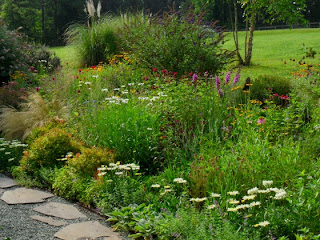A Staggering Japanese Iris Vignette
12:50 PM | Posted by
Donald
 |
| Iris ensata. June 2012 |
Although I always dread the fall chore of digging up big clumps of Japanese iris every three years, I must admit that doing so opens the opportunity to try different vignettes.
The purple Japanese iris (tag long gone and so it is unknown) is a great bloomer. With my last division of this iris, I planted it graduated—or staggered—up a slope rather than on the same level. My logic was that each clump grows quickly and by planting each divided piece up the slope instead of grouped on the same level, I could hopefully extend the number of years before needing to divide again.
Was the resulting design a "staggering" achievement or defeat?
 |
| Overhead view of the "staggered" planting. |
 |
| Path view of the staggered planting on the slope. Combination includes: Foreground: spirea, Japanese blood grass, hardy ageratum. Middle: echinacea foliage, shasta blooms. Beside irises: monarda foliage, nigella seed pods, white iris blooms. |
The staggered planting adds to the layers of foliage, flowers and even seed pods as the garden fluxes with different bloom times of the surrounding plants. In such a large garden, I have to rely upon foliage that looks good throughout the growing season.
I'm particularly fond of the deep purple striped seed pods of nigella damascena 'Miss Jekyll Blue' (love-in-a-mist) and lacy foliage with the purple iris blooms.
The monarda and echinacea foliage provide wider leaves, while the Japanese blood grass foliage is pointed and echoes the deeper red from the spirea. The frilly foliage of spirea and ageratum keeps the mass of from looking the same with the gold and bright green colors.
This is a large section of garden, so there are many more perennial players to the sides as well as up and down the slope. The month of June, everything changes so quickly. The blooms of Japanese iris last only a short time, but the long, pointed foliage can be easily blended into the garden.
If you want to grow iris ensata (Japanese iris), the perennials are suitable for zones 4-9 in mostly full sun with moist, acidic soil. Deer will occasionally pick the blooms, but not bother with the foliage. The rabbit will sometimes eat the points of the foliage when it first emerges in spring. Neither has damaged the plants enough to discourage me from using the irises in the deer resistant meadow garden or the gravel garden.
 |
| Stepping back from the nearest-companions from the left view. Evening light casts a blue tone. |
 |
| Looking at the iris another way (right side), the wide green foliage of persicaria amplexicaulis 'Firetail' and deep purple eupatorium rugosum 'Chocolate'. Narrow green foliage of asclepias incarnata is front left. |
 |
| After the iris blooms are gone (right-side view), the foliage blends into the deer resistant meadow garden. Full sun casts amber light. |
Labels:
deer resistant,
Flower,
Garden,
garden design,
Irises,
Japanese iris,
Leaf,
meadow,
Plants G-L
Subscribe to:
Post Comments (Atom)
Categories
- artists
- Asclepias
- Asclepias incarnata
- book review
- butterfly garden
- Container garden
- cottage garden
- Deer
- deer resistant
- drought and xeric
- environment
- Europe
- favorite accent
- favorite combination
- Flower
- flower bulbs and seeds
- food
- fragrance garden
- Garden
- garden design
- garden inspiration
- Gardens
- Gravel
- gravel garden
- home
- Home and Garden
- Hunger Games
- Irises
- Japanese iris
- Leaf
- Little Lime
- meadow
- Monarch
- Monarch Butterflies
- Monarch Butterfly
- Monarda
- Monet
- musings
- North Carolina
- nursery review
- Pest and Disease Control
- Plant
- plant care
- Plants A-F
- Plants G-L
- Plants M-Z
- Public
- Purple milkweed
- rabbit resistant
- Recreation
- rose_campion
- seasons
- Shopping
- Shrub
- sources
- Stemware
- Sweet pea
- technology
- travel
- United States
- Wayside
- wildlife
- Wine
Powered by Blogger.
Popular Posts
-
By Freda Cameron Although the weather has passed for planting, this is a great time to plan a garden with the children in your family. Durin...
-
George Washington's Mount Vernon is a reminder of the self-sufficiency of farms of historical significance. Did you know that Washingto...
-
Coreopsis ' Star Cluster ' in bloom with companions Eucomis 'Sparkling Burgundy' ( foliage left) echinacea (multiple...
-
The image of a table laden with a bountiful harvest isn't just for Thanksgiving. Local farmers' markets and Community Supported Agri...
-
There are few plants in the garden that are virtually maintenance-free. My favorite foliage plant is carex hachijoensis 'Evergold' ...
-
I tried to make a garden plan when I spread the soil in fall 2006 to create the outer gardens. I researched and researched the right plant...
-
Katie and the Giant Cabbage The idea for Katie’s Krops began with a 9 year old girl and a 40 pound cabbage. In 2008 Katie brought home a ti...
-
These "green" disfigured coneflowers were removed and destroyed. I didn't plant any new " green bloom " echinace...
-
May I see your identification please? Theft comes in many forms and recently garden bloggers have discovered that there are bad guys who wi...
-
By Freda Cameron What is the process of working with a professional garden designer? I asked this question at a local garden center that ha...










0 comments:
Post a Comment